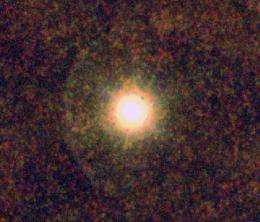Recipe for water: Just add starlight

ESA's (European Space Agency) Herschel infrared space observatory has discovered that ultraviolet starlight is a key ingredient for making water in the atmosphere of some stars. It is the only explanation for why a dying star is surrounded by a gigantic cloud of hot water vapour. These new results will be published tomorrow in Nature.
Every recipe needs a secret ingredient. When astronomers discovered an unexpected cloud of water vapour around the old star CW Leonis in 2001, they immediately began searching for the source. Water is known to be present around several types of stars, but CW Leonis is a “carbon star” and therefore thought not to produce water. Initially they suspected the star’s heat must be evaporating comets or even dwarf planets to produce the water.
Now, Herschel’s PACS (Photodetector Array Camera and Spectrometer) and SPIRE instruments have revealed that the secret ingredient is ultraviolet light, because the water vapour is too hot to have come from the destruction of icy celestial bodies and is distributed throughout the stellar wind, including deep down near the surface of the star itself. This suggests that the water is being created by a previously unsuspected chemical process where ultraviolet radiation from interstellar space is breaking up the carbon monoxide and releasing oxygen atoms that can then react with hydrogen to form water molecules.
Professor Leen Decin from Katholieke Universiteit Leuven, Belgium, who led this research, explained, "We already knew there was water in the vicinity of the star, but the previous assumption was that it was probably due to evaporating icy comets orbiting around the star.” The new Herschel observations have shown that the water is being formed much closer to the star itself, at temperatures approaching 1000oC. Prof Decin added, “This is really exciting, since it is the first time that we have seen a lot of carbon and water molecules co-existing close to a very luminous, but dying, star. Carbon and water are two of the major the building blocks for life as we know it on Earth. The same mechanisms triggered by ultraviolet light might have played a crucial role in prebiotic processes on the early Earth.”
Ultraviolet starlight would normally be blocked by the material flowing from the star as its outer layers billow out in a stellar wind. It was already known that the stellar wind is “clumpy” but the Herschel results have shown that some regions around the star must have no wind. These empty regions allow the ultraviolet light to reach the deepest layers of the star’s atmosphere and initiate the chemical reactions that produce the water.
Professor Mike Barlow of University College London, co-author of the Nature paper, said "The discovery of water vapour from the outflowing wind of a carbon star has required a complete re-evaluation of our models for the chemical processes in such flows and testifies to the exceptional capabilities of the spectrometers on-board the Herschel Space Observatory."
CW Leonis is a red giant star which is only a few times the mass of the Sun but has expanded to hundreds of times its size. Nuclear fusion reactions deep inside the star are converting helium into carbon, much of which has ended up in the outer layers of the star’s atmosphere. It is this abundance of Carbon in the atmospheres of these types of stars that has previously led scientists to believe that water could not exist; with so much carbon all of the oxygen should be locked up in carbon monoxide (CO).
Professor Matt Griffin of Cardiff University, Principal Investigator for Herschel's SPIRE instrument, said, “This is the kind of result that the people who built SPIRE love to see - a real surprise, and one that makes us re-think our ideas about how stars evolve. The discovery of water where it shouldn't really exist shows the power of Herschel to reveal new aspects of the Universe.
“What this result and others are telling us is that there is water everywhere in the Universe - we are seeing it in comets, planets, all over the place in our galaxy and in other galaxies. With Herschel we are going to be able to understand how it helps shape the development and evolution of stars and planets.”
Dr David Parker, Director of Space Science and Exploration for the UK Space Agency, added, “Once again, the Herschel team have wowed us with an amazing new discovery. Herschel is a key part of the UK Space Agency’s programme to explore the ancient Universe and understand how galaxies, stars and planets form. This unique, European space observatory is really excelling itself and continues to unveil the secrets of previously unseen parts of our Universe.”
More information: Nature paper: ‘Warm water vapour in the sooty outflow from a luminous carbon star’
Provided by Science and Technology Facilities Council



















